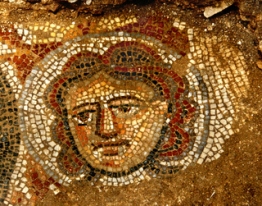 This mosaic of the biblical character Samson was found during an archaeological dig at the ancient village of Huqoq in Israel.
This mosaic of the biblical character Samson was found during an archaeological dig at the ancient village of Huqoq in Israel.
The synagogue, which is being described by the Israeli Antiquities Authority (IAA) as "monumental," dates back to the Late Roman period (between the fourth and fifth centuries C.E.). It is located at Huqoq, an ancient Jewish village that lies just a few miles west of Capernaum, in Galilee.
"This discovery is significant because only a small number of ancient (Late Roman) synagogue buildings are decorated with mosaics showing biblical scenes, and only two others have scenes with Samson (one is at another site just a couple of miles from Huqoq)," said Jodi Magness of the University of North Carolina, who is co-conducting the dig, in a statement.
The mosaic is made up of small, colored stone cubes that have been arranged to show Samson placing lit torches between the tails of foxes. The image depicts a story in Judges 15, in which Samson sends the foxes, with their tails tied together and the torches lit, into the grain fields of his enemies, the Philistines, in order to destroy their land and produce. Samson is most well-known for his long hair and the extraordinary strength given to him by God in the Bible.
In addition to Samson's portrait, another part of the mosaic features what appears to be the faces of two women flanking a round medallion, which contains in it an inscription in Hebrew that refers to the rewards given to those who do good deeds.
Magness, who serves as the Kenan Distinguished Professor for the Department of Religious Studies at UNC's College of Arts and Sciences, says the way the synagogue was constructed and decorated suggests that the village it was built in was wealthy.
"Our mosaics are also important because of their high artistic quality and the tiny size of the mosaic cubes. This, together with the monumental size of the stones used to construct the synagogue's walls, suggest a high level of prosperity in this village, as the building clearly was very costly," she said.
Magness co-conducted the dig alongside David Amit of the IAA. The excavation is being sponsored by UNC, Trinity University, Brigham Young University, the University of Oklahoma and the University of Toronto. Staff and students from these schools are also participating in the dig.
In an interview with CNN, Magness said another image of Samson, in which he is shown killing Philistines with the jawbone of a donkey, can be found in another nearby synagogue site at Wadi Hamam. The only other known image of the biblical warrior at an ancient synagogue is in modern-day Turkey, and it depicts various scenes from his life.
Although she is unsure why images of Samson appeared in two synagogues that are so close to each other, Magness says she intends to find out. This marks the second year of excavations at this particular site in Huqoq, and more work on the site has been scheduled to continue next summer.
